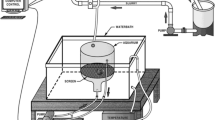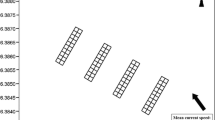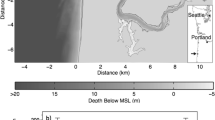Abstract
Oysters in suspended aquaculture filter out particulates from the water column and release pseudofeces and feces (collectively called biodeposits) back to the water column. These biodeposits consist of dense assemblages of labile organic matter that quickly settle to the sediment surface. To properly quantify the environmental effects of biodeposition from suspended aquaculture, it is necessary to determine where the biodeposits settle. An analytical/numerical model was developed for suspended aquaculture systems to predict the spatial distribution of biodeposits; input parameters include water depth, tidal elevation, biodeposit settling rate, and wind and tidally driven current velocity. The biodeposit model was validated in three shallow Cape Cod, Massachusetts, estuaries characterized by low-energy hydrodynamics. For each site, model-predicted carbon deposition was regressed against measured carbon remineralization (determined from sediment oxygen uptake) obtained from intact sediment cores collected along a gradient of predicted carbon deposition. Results showed that in summer, nearly all carbon deposited was remineralized but that the fraction of deposited carbon that is remineralized decreases considerably with declining temperatures in the fall. The simple analytical/numerical model developed and validated in this study provides a tool for commercial oyster growers and environmental managers to assess the effect of organic matter deposition by suspended oyster aquaculture over the growing season. This approach can be applied in shallow depositional coastal systems.














Similar content being viewed by others
References
Archer, A., J. Reitsma, and D. Murphy. 2014. A comparison of bottom and floating gear for growing American oysters (Crassostrea virginica) in southeastern Massachusetts. Woods Hole Sea Grant Cape Cod Coop. Ext.
Berner, R. A. 1980. Early Diagenesis: A Theoretical Approach. Princeton: Princeton University Press.
Buttner, J., G. Flimlin, and D. Webster. 2008. Marine Aquaculture Species for the Northeast. 103–2008. College Park, Maryland: Northeastern Regional Aquaculture Center.
Callier, M., A. Weise, C. McKindsey, and G. Desrosiers. 2006. Sedimentation rates in a suspended mussel farm (Great-Entry Lagoon, Canada): Biodeposit production and dispersion. Marine Ecology Progress Series 322: 129–141. https://doi.org/10.3354/meps322129.
Chamberlain, J. 2001. Impacts of biodeposits from suspended mussel (Mytilus edulis L.) culture on the surrounding surficial sediments. ICES Journal of Marine Science 58: 411–416. https://doi.org/10.1006/jmsc.2000.1037.
Comeau, L.A., A.L. Mallet, C.E. Carver, and T. Guyondet. 2014. Impact of high-density suspended oyster culture on benthic sediment characteristics. Aquaculture Engineering 58: 95–102. https://doi.org/10.1016/j.aquaeng.2013.12.004.
Cromey, C.J., T.D. Nickell, and K.D. Black. 2002. DEPOMOD—modelling the deposition and biological effects of waste solids from marine cage farms. Aquaculture 214: 211–239. https://doi.org/10.1016/S0044-8486(02)00368-X.
Doiron, S. 2008. Reference Manual for Oyster Aquaculturists. Fredericton, New Brunswick: New Brunswick Department of Agriculture, Fisheries and Aquaculture.
Everett, R.A., G.M. Ruiz, and J.T. Carlton. 1995. Effect of oyster mariculture on submerged aquatic vegetation: An experimental test in a Pacific Northwest estuary. Marine Ecology Progress Series 125: 205–217.
FAO. 2020. The State of World Fisheries and Aquaculture 2020. Rome: Sustainability in action.
Forrest, B.M., and R.G. Creese. 2006. Benthic impacts of intertidal oyster culture, with consideration of taxonomic sufficiency. Environmental Monitoring and Assessment 112: 159–176.
Foster-Smith, R.L. 1975. The effect of concentration of suspension on the filtration rates and pseudofaecal production for Mytilus edulis L., Cerastoderma edule (L.) and Venerupis pullastra (Montagu), Journal of Experimental Marine Biology and Ecology 17.1: 1–22. https://doi.org/10.1016/0022-0981(75)90075-1
Gaurier, B., G. Germain, Y. Kervella, J. Davourie, F. Cayocca, and P. Lesueur. 2011. Experimental and numerical characterization of an oyster farm impact on the flow. European Journal of Mechanics-B/Fluids 30: 513–525. https://doi.org/10.1016/j.euromechflu.2011.05.001.
Giles, H., N. Broekhuizen, K.R. Bryan, and C.A. Pilditch. 2009. Modelling the dispersal of biodeposits from mussel farms: The importance of simulating biodeposit erosion and decay. Aquaculture 291: 168–178. https://doi.org/10.1016/j.aquaculture.2009.03.010.
Giles, H., and C. Pilditch. 2006. Effects of mussel (Perna canaliculus) biodeposit decomposition on benthic respiration and nutrient fluxes. Marine Biology 150: 261–271. https://doi.org/10.1007/s00227-006-0348-7.
Giles, H., and C. Pilditch. 2004. Effects of diet on sinking rates and erosion thresholds of mussel Perna canaliculus biodeposits. Marine Ecology Progress Series 282: 205–219. https://doi.org/10.3354/meps282205.
Grant, J., P. Cranford, B. Hargrave, M. Carreau, B. Schofield, S. Armsworthy, V. Burdett-Coutts, and D. Ibarra. 2005. A model of aquaculture biodeposition for multiple estuaries and field validation at blue mussel (Mytilus edulis) culture sites in eastern Canada. Canadian Journal of Fisheries and Aquatic Sciences 62: 1271–1285. https://doi.org/10.1139/f05-033.
Grenz, C., M. Hermin, D. Baudinet, and R. Daumas. 1990. In situ biochemical and bacterial variation of sediments enriched with mussel biodeposits. Hydrobiologia 207: 153–160. https://doi.org/10.1007/BF00041452.
Hartstein, N.D., and C.L. Stevens. 2005. Deposition beneath long-line mussel farms. Aquaculture Engineering 33: 192–213. https://doi.org/10.1016/j.aquaeng.2005.01.002.
Hatakeyama, Y., T. Kawahata, M. Fujibayashi, O. Nishimura, and T. Sakamaki. 2021. Sources and oxygen consumption of particulate organic matter settling in oyster aquaculture farms: Insights from analysis of fatty acid composition. Estuarine, Coastal and Shelf Science 254. https://doi.org/10.1016/j.ecss.2021.107328
Haven, D.S., and R. Morales-Alamo. 1966. Aspects of biodeposition by oysters and other invertebrate filter feeders. Limnology and Oceanography 11: 487–498. https://doi.org/10.4319/lo.1966.11.4.0487.
Haven, D.S., and R. Morales-Alamo. 1972. Biodeposition as a factor in sedimentation of fine suspended solids in estuaries. Geological Society of America Memoir 133: 121–130. https://doi.org/10.1130/MEM133-p121.
Higgins, C.B., K. Stephenson, and B.L. Brown. 2011. Nutrient bioassimilation capacity of aquacultured oysters: Quantification of an ecosystem service. Journal of Environmental Quality 40: 271–277. https://doi.org/10.2134/jeq2010.0203.
Higgins, C., C. Tobias, M. Piehler, A. Smyth, R. Dame, K. Stephenson, and B. Brown. 2013. Effect of aquacultured oyster biodeposition on sediment N2 production in Chesapeake Bay. Marine Ecology Progress Series 473: 7–27. https://doi.org/10.3354/meps10062.
Hoellein, T.J., and C.B. Zarnoch. 2014. Effect of eastern oysters (Crassostrea virginica) on sediment carbon and nitrogen dynamics in an urban estuary. Ecological Applications 24: 271–286. https://doi.org/10.1890/12-1798.1.
Kaspar, H.F., P.A. Gillespie, I.C. Boyer, and A.L. MacKenzie. 1985. Kaspar, H. F., P. A. Gillespie, I. C. Boyer, and A. L. MacKenzie. Effects of mussel aquaculture on the nitrogen cycle and benthic communities in Kenepuru Sound, Marlborough Sounds. New Zealand Marine Biology 85: 127–136.
Kellogg, M.L., A.R. Smyth, M.W. Luckenbach, et al. 2014. Use of oysters to mitigate eutrophication in coastal waters. Estuarine, Coastal and Shelf Science 151: 156–168. https://doi.org/10.1016/j.ecss.2014.09.025.
Kervella, Y., G. Germain, B. Gaurier, J.-V. Facq, F. Cayocca, and P. Lesueur. 2010. Experimental study of the near-field impact of an oyster table on the flow. European Journal of Mechanics-B/Fluids 29: 32–42. https://doi.org/10.1016/j.euromechflu.2009.09.002.
Khalil, K., M. Raimonet, A. Laverman, C. Yan, F. Andrieux-Loyer, E. Voiller, B. Deflandre, O. Ragueneau, and C. Rabouille. 2013. Spatial and temporal variability of sediment organic matter recycling in two temperate eutrophicated estuaries. Aquatic Geochemistry 19: 517–542.
Labrie, M.S. 2021. Quantifying Impacts of Suspended Oyster Aquaculture on Nitrogen Cycling in a Southeastern Massachusetts Coastal Embayment. PhD Dissertation: University of Massachusetts, Dartmouth, MA, USA.
Li, J., Y.P. Wang, J. Du, F. Luo, P. Xin, J. Gao, B. Shi, X. Chen, and S. Gao. 2021a. Effects of Meretrix meretrix on sediment thresholds of erosion and deposition on an intertidal flat. Ecohydrology and Hydrobiology 21: 129–141. https://doi.org/10.1016/j.ecohyd.2020.07.002.
Li, J., X. Chen, I. Townend, B. Shi, J. Du, J. Gao, X. Chuai, Z. Gong, and Y.P. Wang. 2021b. A comparison study on the sediment flocculation process between a bare tidal flat and a clam aquaculture mudflat: The important role of sediment concentration and biological processes. Marine Geology. https://doi.org/10.1016/j.margeo.2021.106443.
McKindsey, C.W., M. Lecuona, M. Huot, and A.M. Weise. 2009. Biodeposit production and benthic loading by farmed mussels and associated tunicate epifauna in Prince Edward Island. Aquaculture 295: 44–51. https://doi.org/10.1016/j.aquaculture.2009.06.022.
Newell, R.I.E., T.R. Fisher, R.R. Holyoke, and J.C. Cornwell. 2005. Influence of Eastern Oysters on Nitrogen and Phosphorus Regeneration in Chesapeake Bay, USA, p. 93–120. In R.F. Dame and S. Olenin [eds.], The Comparative Roles of Suspension-Feeders in Ecosystems. Springer-Verlag.
Newell, R.I.E., and C.J. Langdon. 1996. Mechanisms and physiology of larval and adult feeding. p. 185–230. In V. S. Kennedy, R. I. E. Newell, and A. Eble [eds.], The eastern oyster, Crassostrea virginica. Maryland Sea Grant Publication.
Nixon, S.W., C.A. Oviatt, J. Garber, and V. Lee. 1976. Diel metabolism and nutrient dynamics in a salt marsh embayment. Marine Ecology Progress Series 141: 263–274. https://doi.org/10.2307/1936187.
Ottmann, F., and J.M. Sornin. 1982. Relationship between marine bottom elevation and various types of marine culture. Atlantica 5: 88–89.
Parsons, T.R., Y. Maita, and C. Lalli. 1989. Manual of Chemical and Biological Methods for Seawater Analysis. Pergamon Press, p. 173.
Rudnick, D.T., and C.A. Oviatt. 1986. Seasonal lags between organic carbon deposition and mineralization in marine sediments. Journal of Marine Research 44: 815–837. https://doi.org/10.1357/002224086788401594.
Shaw, K.C., B.L. Howes, and D. Schlezinger. 2018. Macroalgal composition and accumulation in New England estuaries. Journal of Environmental Management 206: 246–254.
Shi, B., P.D. Pratolongo, Y. Du, J. Li, S.L. Yang, J. Wu, K. Xu, and Y.P. Wang. 2020. Influence of macrobenthos (Meretrix meretrix Linnaeus) on erosion‐accretion processes in intertidal flats: A case study from a cultivation zone. Journal of Geophysical Research: Biogeosciences 125: p.e2019JG005345.
Tenore, K.R., and W.M. Dunstan. 1973. Comparison of feeding and biodeposition of three bivalves at different food levels. Marine Biology 21 (3): 190–195.
Testa, J., D. Brady, J. Cornwell, M. Owens, L. Sanford, C. Newell, S. Suttles, and R. Newell. 2015. Modeling the impact of floating oyster (Crassostrea virginica) aquaculture on sediment-water nutrient and oxygen fluxes. Aquaculture Environment Interactions 7: 205–222. https://doi.org/10.3354/aei00151.
Thamdrup, B., J.W. Hansen, and B.B. Jørgensen. 1998. Temperature dependence of aerobic respiration in a coastal sediment. FEMS Microbiology Ecology 25 (2): 189–200. https://doi.org/10.1111/j.1574-6941.1998.tb00472.x.
Town of Mashpee Sewer Commission. 2015. Final recommended plan/final environmental impact report. Comprehensive Wastewater Management Plan, Town of Mashpee. Hyannis: GHD Inc.
Town of Orleans Water Quality and Wastewater Planning. 2016. Amended Comprehensive Wastewater Management Plan – Preliminary Draft. Pocasset: AECOM Technical Services Inc.
U.S. Department of Agriculture. 2019. 2017 Census of Agriculture: Census of Aquaculture (2018). (AC-17-SS-2). https://www.nass.usda.gov/Publications/AgCensus/2017/Online_Resources/Aquaculture/Aqua.pdf
Weise, A.M., C.J. Cromey, M.D. Callier, P. Archambault, J. Chamberlain, and C.W. McKindsey. 2009. Shellfish-DEPOMOD: Modelling the biodeposition from suspended shellfish aquaculture and assessing benthic effects. Aquaculture 288: 239–253. https://doi.org/10.1016/j.aquaculture.2008.12.001.
Widdows, J., M.D. Brinsley, P.N. Salkeld, and M. Elliott. 1998. Use of annular flumes to determine the influence of current velocity and bivalves on material flux at the sediment-water interface. Estuaries 21: 552–559. https://doi.org/10.2307/1353294.
Acknowledgements
The authors thank the United States Environmental Protection Agency Southeast New England Program and the Towns of Orleans and Falmouth for supporting this work. We gratefully acknowledge Science Wares Inc. for maintaining the oyster arrays and their assistance determining oyster survival and growth, and the Westport Director of Marine Services, Chris Leonard, and the Westport River Watershed Alliance who assisted in gear construction and deployments in Cockeast Pond. In addition, we thank the Falmouth Marine and Environmental Services Director, Chuck Martinsen, for supplying the oysters and gear for the Bournes Pond site. Finally, we thank D.R. Schlezinger, J. Benson, S. Horvet, A. Unruh, and N. Uline of the Coastal Systems Program at SMAST-UMD. We sincerely appreciate the helpful comments of the two anonymous reviewers whose recommendations significantly improved this manuscript.
Author information
Authors and Affiliations
Corresponding author
Additional information
Communicated by Lijun Hou
Rights and permissions
About this article
Cite this article
Labrie, M.S., Sundermeyer, M.A. & Howes, B.L. Modelling the Spatial Distribution of Oyster (Crassostrea virginica) Biodeposits Settling from Suspended Aquaculture. Estuaries and Coasts 45, 2690–2709 (2022). https://doi.org/10.1007/s12237-022-01096-4
Received:
Revised:
Accepted:
Published:
Issue Date:
DOI: https://doi.org/10.1007/s12237-022-01096-4




